Indexation In Life Insurance: How Do You Index Link A Policy?
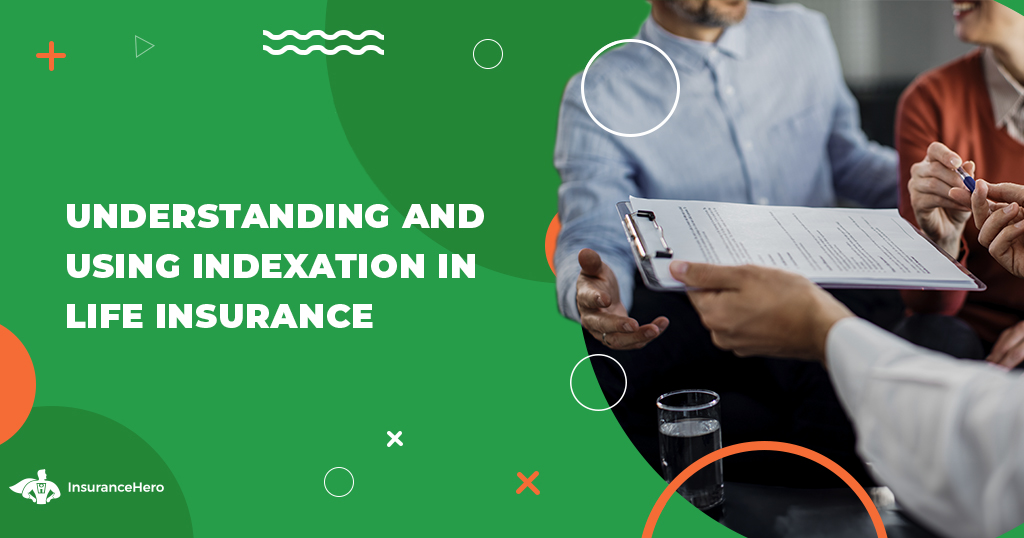
Have you ever felt the pinch of rising costs when you check your bank account? The cost of living appears to be continually increasing.
In a world where prices are on an uphill journey, have you ever considered how this could impact something as crucial as your life insurance indexation?
We all buy life insurance for peace of mind. But what if we told you that peace might be short-lived without indexation?
Staying financially prepared can be stressful in our unpredictable economic climate, with fluctuating inflation rates and variable stock market performance.
This guide explains indexed universal life policies and why they are designed to protect you from financial uncertainties.
Look further, and you’ll understand the basics and learn how your decisions – whether to opt into or out of having your policy indexed – can shape your financial journey.
Compare Life Insurance · No Obligation · Free Quote Form

The Basics of Indexation in Life Insurance
If you’re new to the world of life insurance, terms like ‘indexation’ might sound a bit puzzling. Don’t worry – we’re here to simplify this often misunderstood subject.
Indexation is a feature that can be added to your cover even if you have multiple life insurance policies. In short, indexation safeguards your life insurance against inflation, ensuring the policy’s value keeps pace with rising living costs.
It helps ensure that your coverage amount increases over time at a fixed percentage or is linked to consumer price indices, such as those for alcohol, clothing, and education costs.
This approach is used predominantly by universal life insurance providers, particularly those offering Indexed Universal Life (IUL) policies.
These products feature an investment component tied to an equity index, which adds complexity and potential growth opportunities compared to traditional term life insurance.
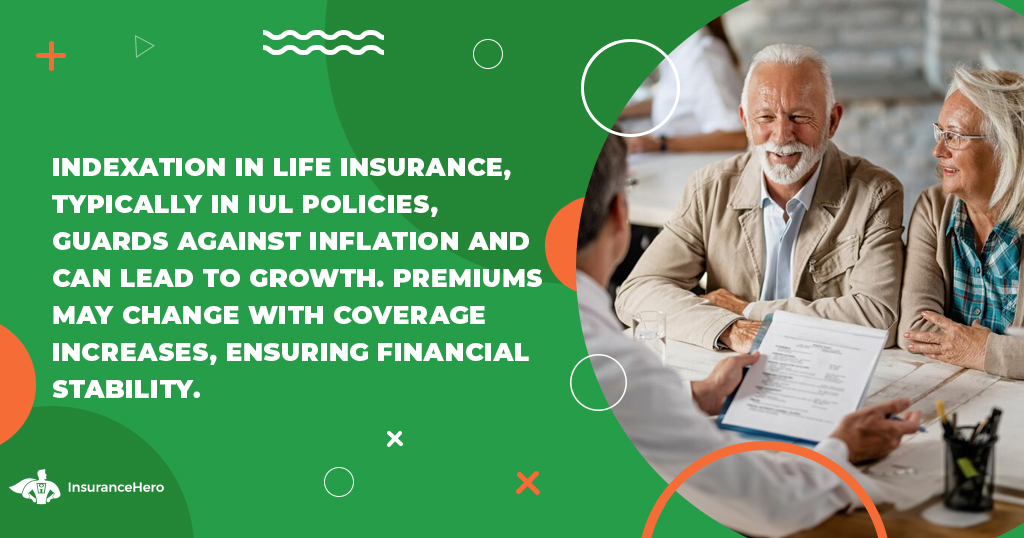
You might now ask how this affects premiums. The short answer is that they change, too. With indexed universal life insurance policies, premium amounts are typically flexible; however, they may increase if the cover rises due to index-linking.
A crucial point about IUL policies is their cash value component—an investment vehicle that somewhat reflects stock market performance without directly investing in stocks.
This gives rise to what some call ‘upside potential,’ where cash values could grow based on positive changes in the chosen equity index—a perk not often found in standard whole or term life insurance.
Remember: Indexation protects your policy against inflation, maintaining its real value over time.
It’s a feature worth considering if you’re planning for long-term financial freedom, but always be aware of potential changes in premiums.
Benefits and Drawbacks of Index Linking Your Policy
When you choose to index-link your life insurance policy, there are both benefits and potential drawbacks that you need to consider. This section will help shed some light on them.
Indexed Universal Life Insurance (IUL), a type of permanent life insurance, is one option that provides unique growth opportunities.
Unlike whole life insurance policies with a guaranteed cash value component but limited upside potential, IULs can give you more room for financial freedom.
IUL policies work by tying the cash value account in part to an equity index, such as the FTSE 100.
If the stock market performs well, your indexed universal life policy could see significant gains, much more than what’s typically possible with other types of coverage, such as term or whole life insurance.
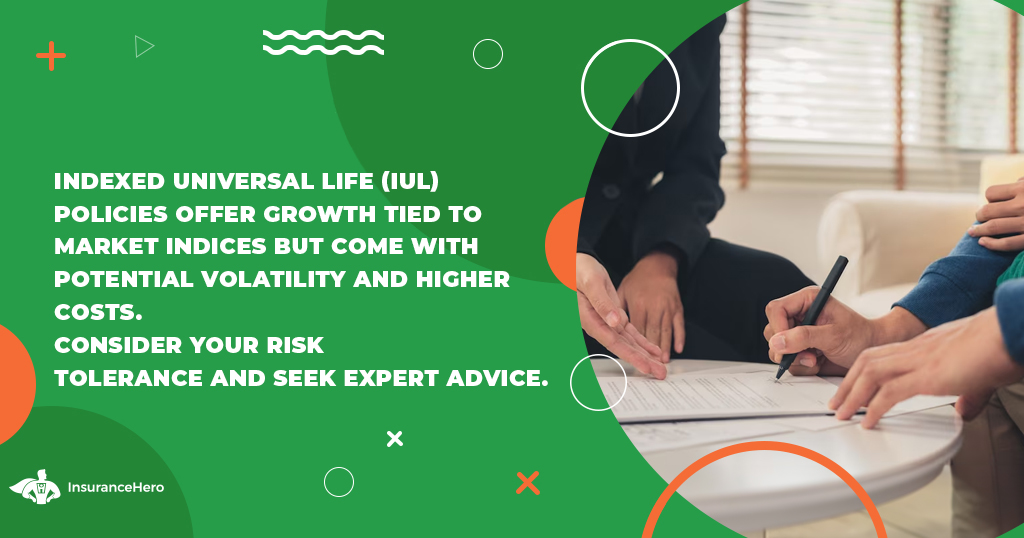
This type of policy not only protects against death but also serves as an investment vehicle. It gives people who want their money working harder for them a chance at better returns without needing direct exposure to stocks or bonds themselves.
All this sounds promising; however, it’s crucial not to overlook certain risks associated with indexed universal life insurance policies as well.
One significant consideration is volatility: if stock market performance falters, then so might your policy’s returns.
Bear in mind that while higher gains compared with traditional options may exist when times are good, the opposite holds when markets perform poorly.
But remember, even during these periods where indices drop substantially, because they’re “indexed”, no losses should be incurred from poor performances alone.
If unpredictability isn’t something you’re comfortable with and would rather stick towards stability over time, then perhaps IULs might not be the best choice for you. Considering the additional features, IULs can come with higher costs.
Opting In and Out of Indexation
Exploring the complexities of life insurance can be simplified with the proper guidance. Deciding on indexation is relatively straightforward, provided you have the necessary knowledge to make an informed choice.
However, it would be best to have advice on navigating your options.
If you’ve decided that adding indexation to your policy makes sense for you, getting started is simple.
Firstly, contact your chosen provider directly or use their customer service channels. If you don’t already have one, be clear that you’d like an indexed universal life insurance policy.
You’ll likely need to fill out some paperwork or answer a few questions online as part of the insurer’s underwriting process.
Once complete, they will adjust the terms accordingly so that any increase in cost due to inflation protection becomes automatic each year at the time of your policy anniversary.

In contrast to opting into indexation, where coverage increases along with rising costs, there may come a time when this no longer suits your needs and circumstances.
For instance, health transport costs may decrease significantly due to declining global oil prices.
Whatever the reason – big or small – remember that opting out is also an option.
- Contact your insurance provider straight away via phone call or email.
- Let them know about your desire to make changes regarding the removal of policies from being indexed.
- Your request should then be processed and confirmed within a few days, if not sooner, depending on their turnaround times.
Note: Remember that the changes you make can impact your policy obligations and potential death benefit payout. So, it’s always worth asking questions if there are any uncertainties.
Remember that whether you opt into or out of indexation, both options have unique benefits that should be weighed carefully. Insurance providers offer this flexibility because they understand life isn’t a one-size-fits-all scenario.
Takeaway: Life insurance indexation doesn’t have to be complicated. To opt in, just get in touch with your provider and complete some paperwork. If you decide it’s not for you anymore, a quick call or email will let them know you want out. But remember: changes can affect your policy terms and payout amount.
The Impact of Indexation on Life Insurance Coverage Amount
When considering your life insurance protection, it’s easy to overlook that prices generally increase with time. But with indexation, your coverage amount can grow in line with inflation.
To start, let’s understand what indexation means for a life insurance policy.
Simply put, an indexed life insurance policy is one where the death benefit and sometimes even the cash value component rise each year based on a specific inflation measure or another financial indicator.
In practical terms, if you’ve got £100k worth of cover today and there’s 5% inflation this year (an example), next year, your coverage could be bumped up to £105k without needing more medical checks.
This helps keep pace with rising costs, such as education expenses and healthcare transportation costs, which are included in calculating the consumer price index.
This process continues every policy anniversary until the policyholder reaches either a pre-determined age or the maximum sum assured by the underwriting insurer when setting out their insurance policy terms. So, essentially, indexing lets you buy some peace from future uncertainty.
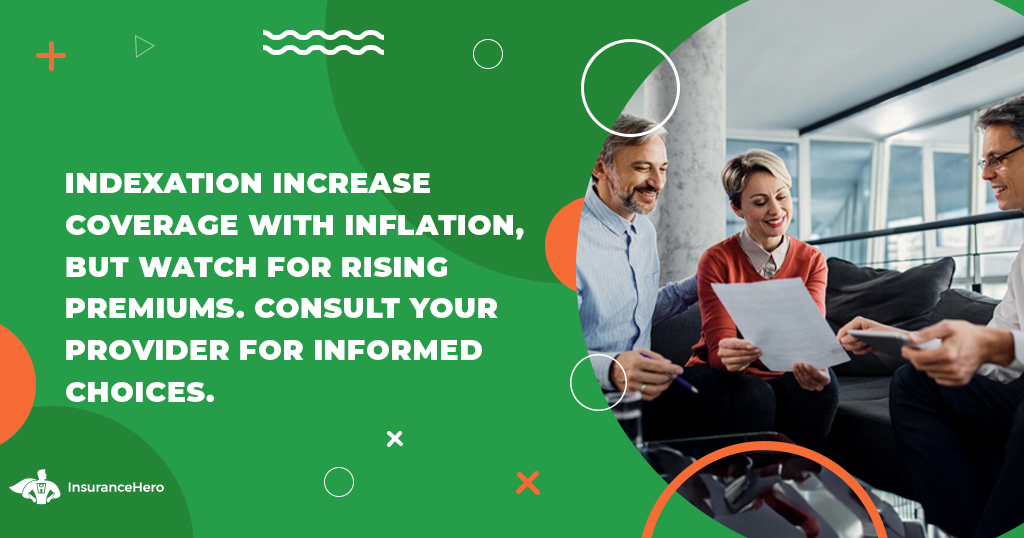
You might ask: Does this mean I have to pay more? The short answer is yes; as your cover increases due to adding indexation, premiums will increase too, but not necessarily at an equal rate.
These calculations also factor in other variables, such as stock market performance.
An important point is that while most policies designed for income protection offer the option to add indexation automatically, not all do.
It’s always best practice to clarify how things work, specifically with any chosen provider, before making final decisions.
Life insurance providers often offer indexation as a way to help maintain the real value of your benefit payout.
It’s worth noting that this feature can be especially valuable if you’re younger, as there’s more time for inflation to erode the value of a fixed sum.
In wrapping things up, you might find indexation a bit dry. Yet, comprehending it could mean saving thousands of pounds on your final payout.
So, don’t overlook future price hikes when pondering over life insurance coverage. Always question whether incorporating indexation suits your needs.
Don’t forget that costs rise over time. With indexation, your cover can keep up with inflation. It means the death benefit and sometimes cash value increase yearly based on a specific measure like inflation. So, if you have £100k coverage today and there’s 5% inflation this year – next year, it could be worth more. That’s right; your £100k might turn into £105k just because of how indexation works to protect you against rising costs.
Key Indexation Terms to Know
If you’re looking into life insurance policies, you’ve probably come across a handful of terms that left you scratching your head. Don’t worry – we’ve got your back with some key indexation terms that’ll make things crystal clear.
1. Indexed Universal Life Insurance (IUL)
I mentioned it briefly, but the first term on our list is Indexed Universal Life Insurance or IUL. An IUL policy is a type of universal life insurance product that lets the cash value component of your policy grow based on the performance of an equity index, such as the FTSE 100.
However, don’t worry—if the stock market dips, these policies typically have built-in floors so that you won’t lose money.
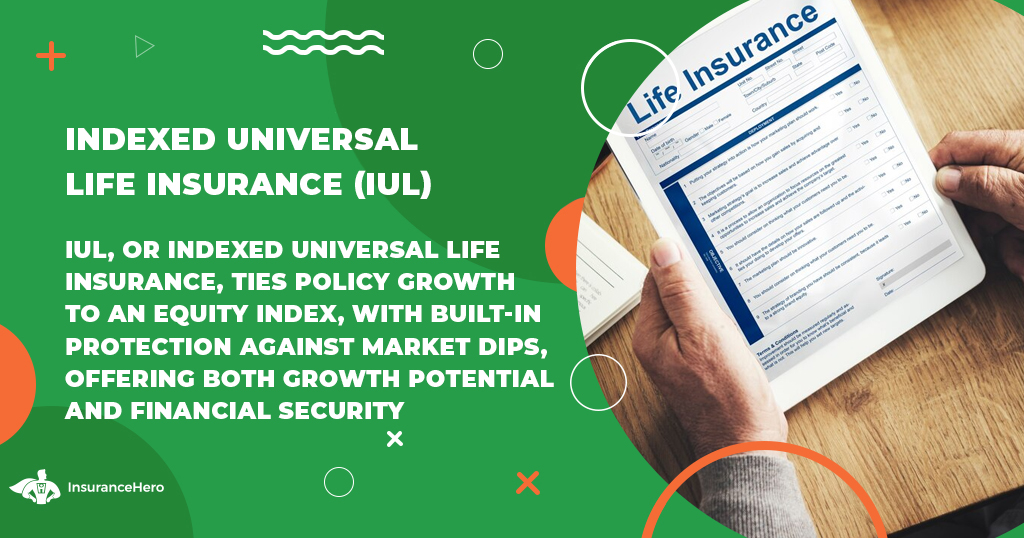
This unique blend offers potential for growth while also providing financial protection against market downturns; think of having cake and eating it, too.
2. Cash Value Component
The next term we need to familiarise ourselves with is the ‘cash value component’. Essentially, this part of an indexed universal life insurance policy is an investment vehicle within the larger plan.
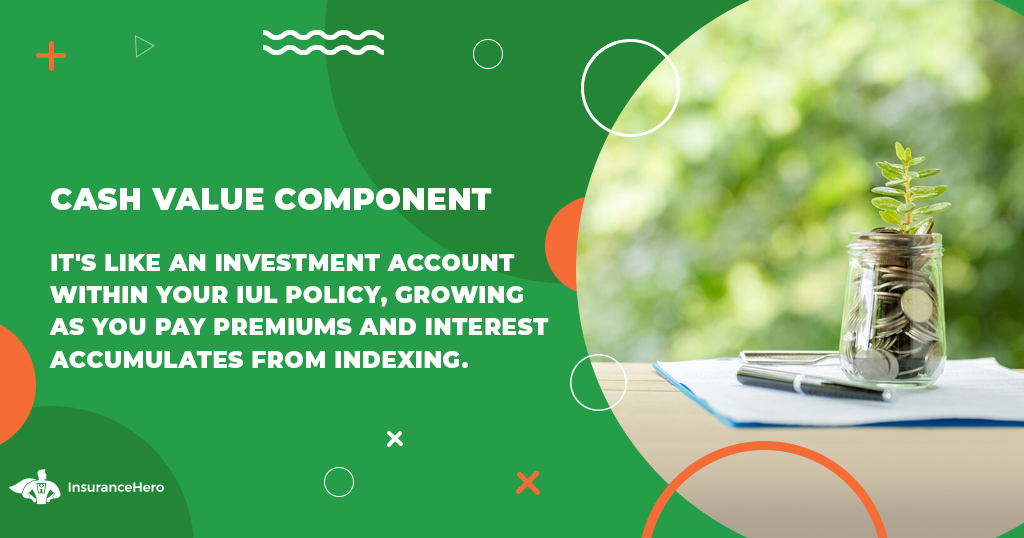
As premiums are paid over time and interest accumulates from the indexing strategy, this portion can increase, providing one more option along their journey towards financial freedom.
3. Insurance Policy Obligations
You might be wondering about the responsibilities associated with owning an IUL policy.
These include keeping premium payments up to date and promptly meeting administrative requirements; there is no room for procrastination in this matter.
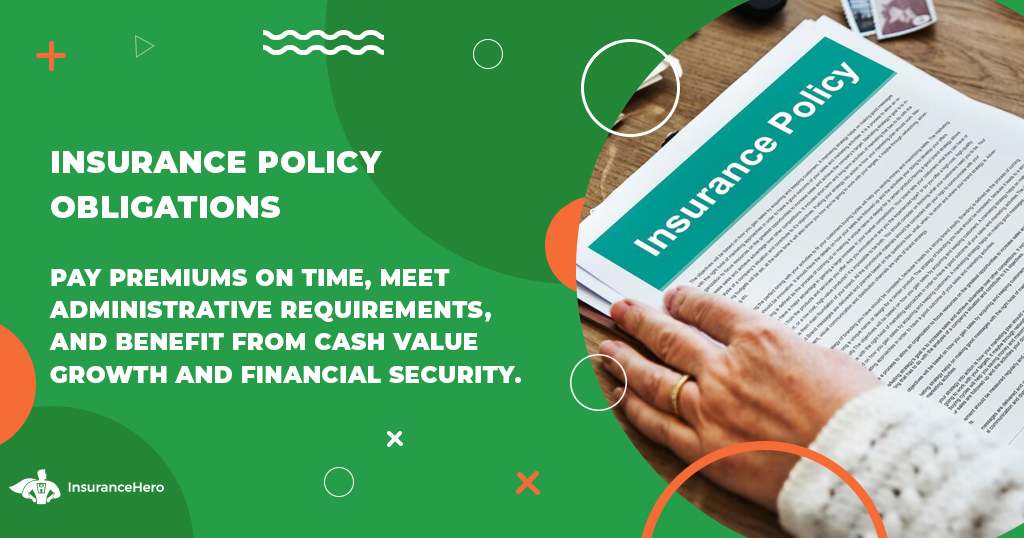
While the jargon may seem intimidating at first – ‘Indexed Universal Life Insurance’, ‘cash value component’, and ‘insurance policy obligations’ – it’s not as complicated as you might think. IUL essentially lets your cash value increase along with market performance but also shields you from any potential downturns. Make sure to keep up with your premium payments consistently; this is key. Also, getting a grasp on inflation protection can be hugely beneficial for long-term financial security.
Real-Life Scenarios of Indexation in Life Insurance
We’ve all experienced the rising cost of everyday items. But have you ever thought about how inflation might affect your life insurance coverage? Let’s take a closer look at how indexation could be significant in certain situations.
1. The Impact of Hardships on Your Indexed Policy
In times of financial hardship, it may be tempting to dip into your indexed universal life insurance policy early.
After all, the policy’s cash value component builds over time and could provide some relief during tough periods.
However, please note that withdrawing funds or taking loans from this account can reduce the death benefit and cash value.
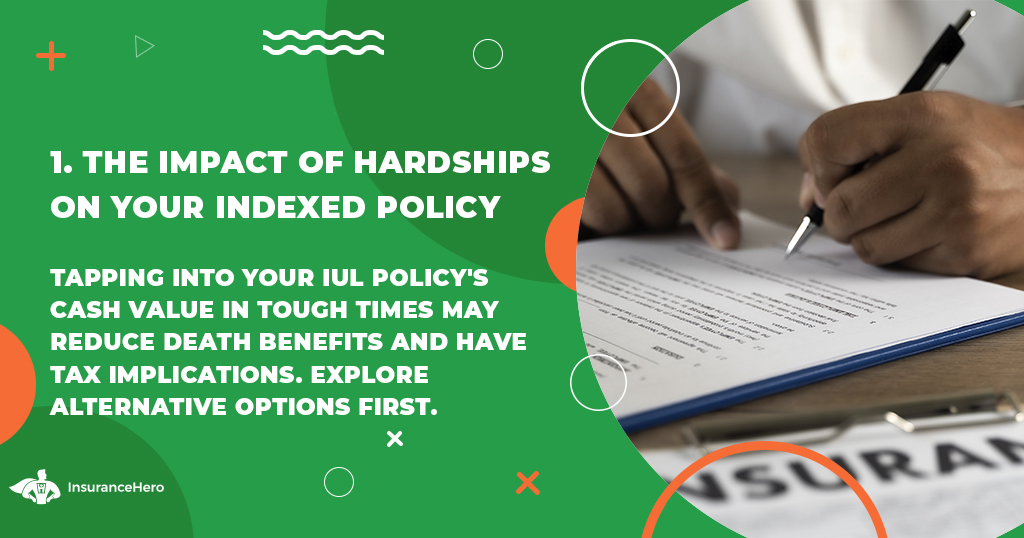
This means less financial protection for loved ones when they need it most, at the time of claim. Such actions may also trigger tax implications.
To avoid these drawbacks, consider alternative avenues before prematurely accessing your indexed policy funds.
2. Unexpected Job Loss
Let’s imagine Sarah has been paying premiums towards her indexed universal life insurance policy for several years, but suddenly loses her job due to unforeseen circumstances.
Her initial reaction might be panic – will she lose her coverage if she fails to pay premiums?
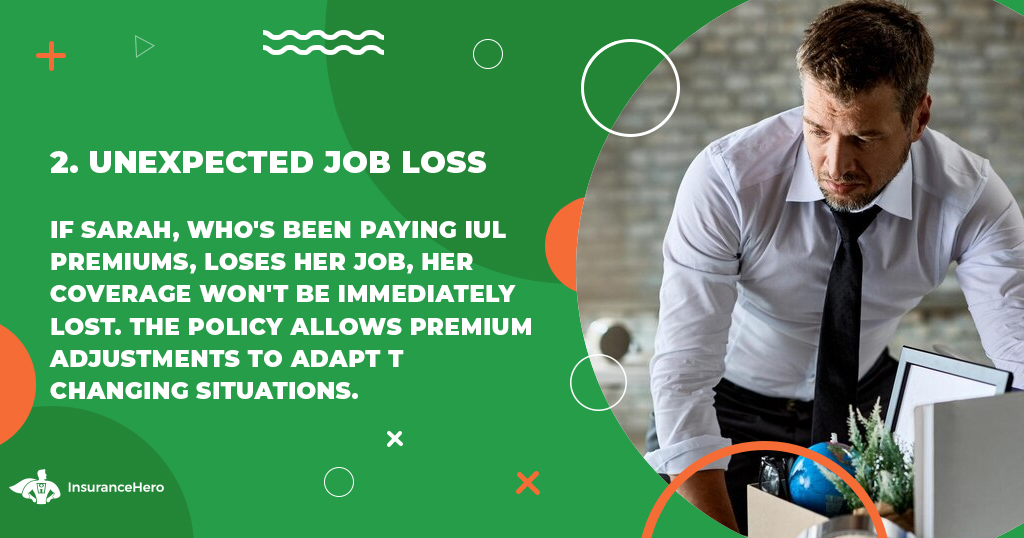
Fear not. The flexibility inherent in an IUL policy allows premium payments to vary based on changing personal situations without immediately resulting in coverage loss.
3. Inflation Protection Benefits
“How does my fixed percentage increase cope with inflation?” asks Peter, a retired school teacher keen on protecting his financial freedom. With an indexed policy, he can rest easy.
Why? Indexation in life insurance is designed to counter the effects of inflation by increasing the sum assured each year at the policy anniversary.
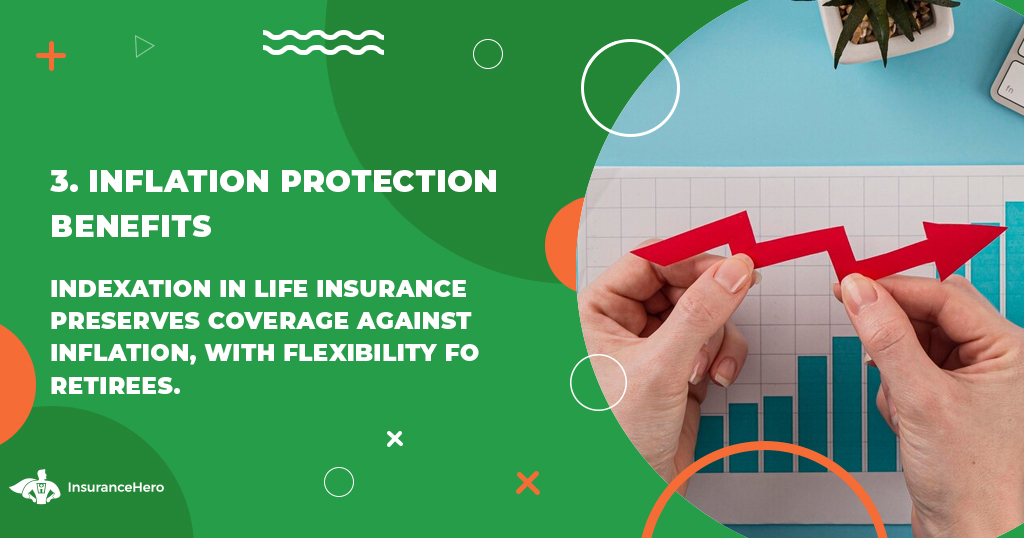
So, even if the costs of education and healthcare transportation continue to rise as predicted by consumer price indices or stock market trends over time, Peter’s teachers’ coverage is also increasing.
This way, he stands a better chance of meeting any future demands.
Life insurance indexation helps counter inflation’s impact on your cover. But be careful not to dip into it during hard times – you might reduce its value and trigger tax implications. Job loss? Don’t panic. The flexibility of indexed policies allows for varied payments without immediate coverage loss. For retirees like Peter, annual increases in the sum assured help maintain financial freedom despite rising costs or unexpected life events.
Comparison Between Fixed Increases and Indexation
If you’ve ever wondered, “What’s the distinction between fixed increases and indexation in a life insurance policy?” then this segment is for you.
When it comes to boosting your life insurance coverage, two standard methods are employed: fixed increases and index-linked increases. Both have merits, but also unique drawbacks worth considering.
Simply put, a fixed increase implies your premiums will rise by a set percentage each year. This approach can give you peace of mind as you know exactly how much extra you’ll pay each year.
However, on the flip side, if inflation rises above your predetermined increase rate (which we all hope won’t happen), then the real value could erode over time.
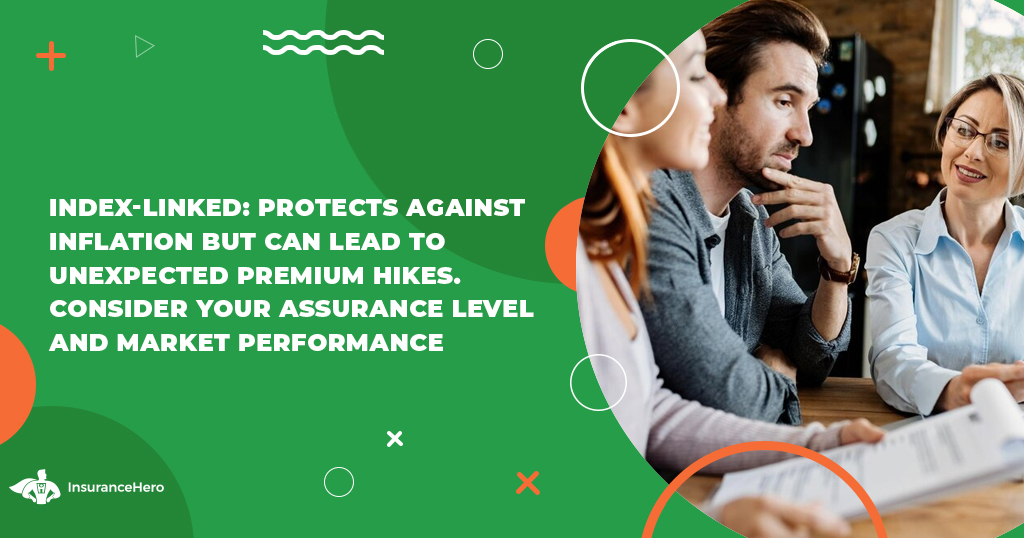
Moving on to index-linking now – think of it as being tied to a financial freedom escalator.
With this method in place within your permanent life insurance or term life policy, rather than having a predetermined annual boost amount locked down at the inception stage, like with ‘fixed’, premium hikes here track changes seen in chosen economic indicators, such as the Consumer Price Index (CPI). So do these linked elements if the CPI goes up by 4%.
While this method would better protect your life insurance benefits and the sum assured against inflation, remember that you could face higher-than-anticipated premium hikes if the CPI or the relevant index spikes suddenly.
When deciding whether to offer fixed increases or index-linked increases in your policy benefits, remember to consider the impact of stock market performance on universal life plans and the level of assurance you’re striving for.
Choosing between fixed increases and index-linked boosts in your life insurance policy is a key decision. Fixed raises offer certainty but can lose value if inflation outstrips them. On the other hand, indexed hikes track economic indicators like CPI, protecting against inflation but risking sudden premium jumps. Remember to consider factors like stock market performance when deciding.
Find the Perfect Life Insurance Plan For You
Decoding the jargon of life insurance indexation isn’t as tricky as it first appears. You’ve got to grips with what indexation means in the context of a life insurance policy and how it can shape your premiums and affect your coverage amount.
You’ve learnt about the advantages and disadvantages of indexed universal life policies compared to others. Deciding whether to opt in or out of having your policy indexed now feels less daunting.
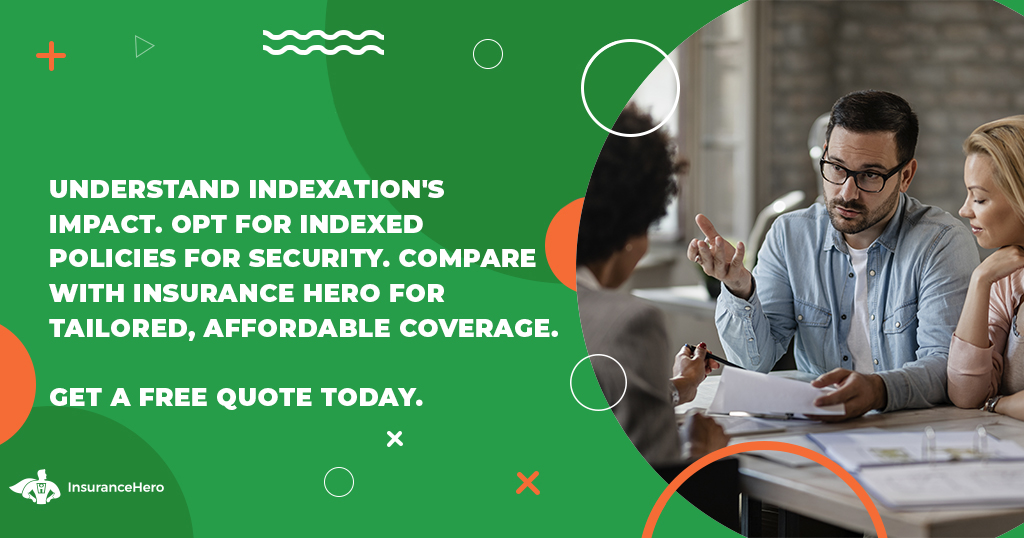
You understand that hard times could hit anyone at any point – but there’s comfort in knowing that an indexed policy is designed for these unpredictable moments.
Comparing fixed increases versus index-linked ones doesn’t feel so intimidating anymore!
In short, by embracing indexation within our policies, we are future-proofing our financial peace against inflation’s sneaky rises and volatile market performance. We’re preparing for tomorrow today – smart move.
Looking for the ideal life insurance tailored to your needs? With Insurance Hero, finding a policy that’s both affordable and comprehensive is a breeze.
Easily compare quotes from various insurers to pinpoint the best fit for your needs and budget.
Whether you’re exploring life insurance, critical illness cover, or income protection, take the next step towards safeguarding your future and get a no-obligation free quote today.
Steve Case is a seasoned professional in the UK financial services and insurance industry, with over twenty years of experience. At Insurance Hero, Steve is known for his ability to simplify complex insurance topics, making them accessible to a broad audience. His focus on clear, practical advice and customer service excellence has established him as a respected leader in the field.



